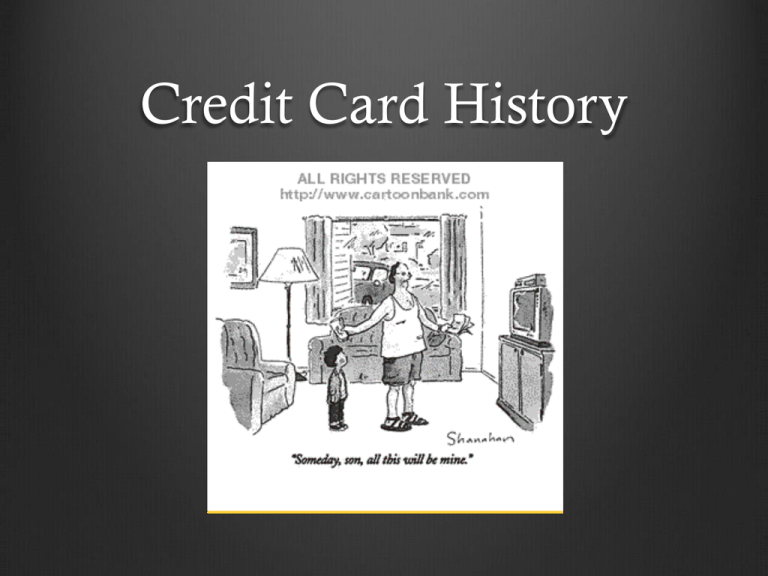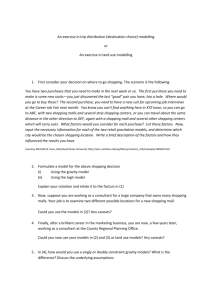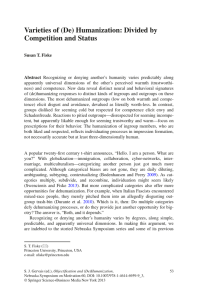Credit Card History
advertisement

Credit Card History Beginnings of Consumer Credit 1890s: Express Travelers Checks introduced 1914: Retailer-issued credit cards 1920s Service stations, department stores and hotel chains began offering credit accounts to customers Late 1930s: Wanamakers introduces revolving credit Credit card originally a tool to bind customers to specific retailers – Not a profit-making operation Idea of store-specific credit began to seem too constraining This led to the development of the universal credit card 1950s Sears credit card transaction Credit and the Postwar Consumers Republic After World War II, Americans began to obtain more discretionary income Increased consumer purchasing opened the door to increasing availability of credit Consumer credit grew from $5.7 billion in 1945 to $375 billion in 1980 1949: Diners Club In 1949, Diners Club issued its first card--made of cardboard--for use in 27 restaurants in New York City. By 1951, nearly 20,000 Americans carried it in their wallet. 1958: American Express and Bank Americard Bank cards proliferated in the 1960s Economies of scale led to the prevalence of Master Charge and Bank Americard (late VISA) Development of large client base was crucial to success in the industry Aggressive marketing led to problems: Unsolicited cards, theft, fraud etc. Computerization spurred a boom in the 1970s and '80s, as did new methods of analyzing consumer data to unearth the most lucrative "revolvers," those who often carry high balances but are unlikely to default. http://www.time.com/time/magazine/article/0,9171,18935 07,00.html#ixzz2PgN6E3aV Legal Issues Equal access, privacy, lost or stolen cards, billing errors Led to government intervention 1974: Federal Privacy Act 1975: Equal Credit Opportunity Act 1978: Financial Institutions Regulatory and Interest Rate Control Act Market Saturation New marketing angles: Affinity credit cards Secured credit cards Prestige credit cards, etc. Discover Card Commercial, 1986 Super Bowl http://www.youtube.com/watch?v=j3NMMNnrzUc James Twitchell, “Two Cheers for Materialism” [H]uman beings love things. In fact, to a considerable degree we live for things. In all cultures we buy things, steal things, exchange things, and horde things. . . . . . In the West, we have even developed the elaborate algebra of commercial law to decide how things are exchanged, divested, and recaptured. Remember, we call these things "goods," as in "goods and services." We don't . . . call them "bads." This sounds simplistic, but it is crucial to understanding the powerful allure of materialism. If you want to understand the potency of American consumer culture, ask any group of teenagers what democracy means to them. You will hear an extraordinary response. Democracy is the right to buy anything you want. Freedom's just another word for lots of things to buy. What do you think of Twitchell’s argument? Most consumption, whether it be of entertainment or in the grocery store, is active. We are engaged. Here is how I watch television. I almost never turn the set on to see a particular show. I am near the machine and think I'll see what's happening. I know all the channels; any eight-year-old does. I am not a passive viewer. I use the remote control to pass through various programs, not searching for a final destination but making up a shopping basket, as it were, of entertainment. Twitchell on Lifestyle Rather than lives, individuals since midcentury have had lifestyles. For better or worse, lifestyles are secular religions, coherent patterns of valued things. Your lifestyle is not related to what you do for a living but to what you buy. One of the chief aims of the way we live now is the enjoyment of affiliating with those who share the same clusters of objects as we do. Twitchell writes, [W]e no longer understand social class as well as we do lifestyle, or what marketing firms call "consumption communities." Observing stuff is the way we understand each other. Even if no one knows exactly how much money it takes to be a yuppie, or how young you have to be, or how upwardly aspiring, everybody knows where yuppies gather, how they dress, what they play, what they drive, what they eat, and why they hate to be called yuppies. In a similar vein, Fiske writes, In late capitalist societies blue-collar workers can earn as much, if not more, than white- or pink-collar workers, so style and taste displace economics as markers of class identity and difference. John Fiske Shopping malls are open invitations to trickery and tenacity. Agree? Disagree? Shopping is the crisis of consumerism: it is where the art and tricks of the weak can inflict the most damage on, and exert the most power over, the strategic interests of the powerful. The shopping mall that is seen as the terrain of guerrilla warfare looks quite different from the one constructed by the metaphor of religion. (12) 80 percent of unemployed people visited the mall at least once a week, and nearly 100 percent of young unemployed women were regular visitors. Class and consumption It would seem that self-display is, for those denied social power, a performance of their ability to be different, of their power to construct their meanings from the resources of the system. It has within it elements of defiance and of pride in self- and sub-cultural identities, and it is pleasurable insofar as it is a means of controlling social relations and one’s cultural environment. (23) Fiske writes, Commodities are not just objects of economic exchange; they are goods to think with, goods to speak with. (25) This recalls Twitchell: [M]ost of the "work" of consumption occurs after the act of purchase. Things do not come complete; they are forever being assembled. In the practices of consumption the commodity system is exposed to the power of the consumer, for the power of the system is not just top-down, or center-outward, but always two-way, always a flux of conflicting powers and resistances. (25) According to Thomas Frank, John Fiske exemplifies “cultural studies’ celebration of difference, transgression, and the carnivalesque.” Frank finds this approach troubling. (See Conquest of Cool, pp. 17-18). Having read ”Shopping for Pleasure,” do find Fiske’s “celebration of difference, transgression, and the carnivalesque” among users of shopping malls persuasive or unpersuasive?







